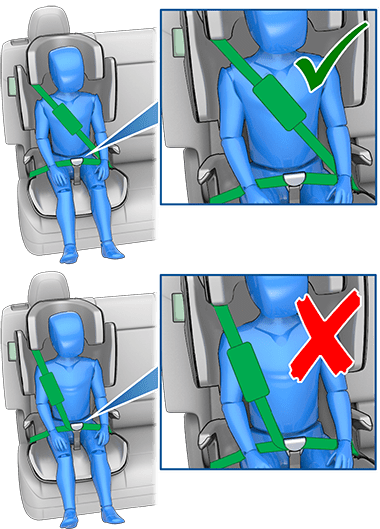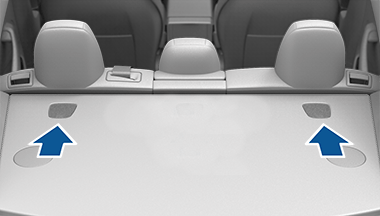Child Safety Seats
Never Seat a Child in the Front Passenger Seat
Refer to the following label fitted to the sun visor.

Tesla strongly recommends toggling the airbag switch OFF before placing a child seat in the front passenger seat.
To disable the passenger front airbag, first ensure the vehicle is in Park. Then touch (see Airbags).
Suitability and Fitting of Child Restraint Systems
All Model 3 seat belts are designed for adults. When seating infants and children, you must:
- Use a child restraint system appropriate for the child’s age, weight, or size (see Recommended Child Restraint Systems Based on Weight).
- Use a child restraint system that is appropriate for the specific seating position in Model 3. Each passenger seat in Model 3 supports a broad range of options. For details on what type of child restraint system can be used in each passenger seat, see Rear Seats.
- Properly install the child restraint system by following the manufacturer's instructions (see Installing Belt-based Child Restraint Systems and Installing ISOFIX/i-Size Child Restraint Systems for general guidelines).
Recommended Child Restraint Systems Based on Weight
Tesla provides recommended child restraint systems based a child's weight group (as defined in ECE R44 “Uniform Provisions Concerning Restraining Devices for Child Occupants"). Although all weight groups can occupy any rear passenger seat in Model 3, the type of child restraint system that can be used in each seat can vary. For example, only belt-based child restraint systems can be used in the rear center passenger seat.
| Stature* | Weight Group** | Child Weight | Tesla Recommended |
|---|---|---|---|
| - | Group 0+ | Up to 13 kg (12 – 18 months) | Maxi-Cosi CabrioFix & Familyfix 3, Cabriofix i-Size Base |
| 45-105 cm | Group I | 9-18 kg | Maxi-Cosi Mica Pro Eco i-Size |
| 100-150 cm | Group II | 15-25 kg | Britax Römer KIDFIX i-Size |
| - | Group III | 22 to 36 kg | Britax Romer Kidfix i-Size |
| - | Booster | Britax Romer Kidfix i-Size (backless booster only) | |
| * per R129 CRS maker's rating ** per R44 CRS | |||
Britax Romer KIDFIX i-Size
When using the Britax Romer KidFix-Size child restraint system as recommended by Tesla for children in group II and group III, you must also use the Britax SecureGuard. When using the Britax SecureGuard, keep the lap belt flat across the child’s hips. Do not put the sash belt under the SecureGuard. For details, refer to the instructions provided by Britax.

The Side Impact Cushion Technology (SICT)™ should be extended when the child seat is installed on the outboard seating positions. Only the SICT closer to the side door needs to be extended. Further the XP-PAD on the child seat should never be removed. Please see the child seat owners manual for further details.
Seating Larger Children

If a child is too large to fit into a child restraint system, but too small to be safely secured using the vehicle's seat belts, use a booster seat appropriate for the child’s age and size. For children needing a booster seat, Tesla recommends using the base of the Britax Romer Kidfix I-Size backless booster with SecureGuard removed. When using and installing a booster seat, carefully follow the instructions provided by the manufacturer.
Two Installation Methods
Among many other variants, there are two general types of child restraint systems based on how they are secured in the seat:
- Belt-based - secured using the vehicle’s seat belts (see Installing Belt-based Child Restraint Systems).
- ISOFIX/i-Size - secured to anchor bars built into the vehicle's seats (see Installing ISOFIX/i-Size Child Restraint Systems).
Some child restraint systems can be installed using either method. Refer to the instructions provided by the manufacturer of the child restraint system to determine which installation method to use and for detailed installation instructions.
In Model 3, belt-based child restraints can be installed in any passenger seat and ISOFIX/i-Size systems can be installed in either of the rear outboard seats. Specific details about the type of child restraint system that can be used in each seat is provided next.
Rear Seats

Infants and children can occupy a rear outboard seat using either belt-based, or ISOFIX (IU)//i-Size (i-U) child restraint systems.
Larger children can also occupy a rear outboard seat using a booster seat, either attached to the lower anchor bars or belted, as described in the instructions provided by the child restraint system manufacturer.
The rear outboard seats support the use of the following ISOFIX/i-Size size classes:
- Size class A, B, and B1 forward-facing.
- Size class C, D and E rear-facing.
Infants can occupy the rear center seat using a rear-facing belt-based child restraint system. Children can occupy the rear center seat using either a rear-facing or a forward-facing belt-based child restraint system.
Larger children can also occupy a rear center seat using a booster seat, installed as described in the instructions provided by the manufacturer of the child restraint system.
Installing Belt-based Child Restraint Systems
Always follow the detailed instructions provided by the manufacturer of the child restraint system. Follow these general guidelines for belt-based child restraint systems:
- Ensure that the child restraint system is appropriate for the weight, height, and age of the child.
- Avoid dressing the child in bulky clothing.
- Do not place any objects between the child and the child restraint system.
- Adjust the child restraint system's harnesses for every child, every trip.
- Place the child restraint system in the appropriate seat and fully extend the seat belt. Route and buckle the seat belt in accordance with the instructions provided by the manufacturer of the child restraint system.

- Allow the seat belt to retract, and remove all slack in the seat belt while firmly pushing the child restraint system into the vehicle's seat.
- Attach the upper tether strap(s), as required by the manufacturer of the child restraint system (see Attaching Upper Tether Straps).
Installing ISOFIX/i-Size Child Restraint Systems
Model 3's rear outboard seating positions are equipped with ISOFIX/i-Size anchor bars. These anchor bars are located between the seat's cushion and back rest. The exact location of each anchor bar is identified by a marking (illustrated below) located on the seat back, directly above its associated anchor bars.

In the second row, install ISOFIX/iSize child safety seats in the outboard seating positions only. Use only a seat belt retained seat in the center position.

To install an ISOFIX/i-Size child restraint system, carefully read and follow the instructions provided by the manufacturer of the child restraint system. These instructions describe how to slide the child restraint system onto the seat’s anchor bars until you hear it "click" into place. You may need to push the child restraint system firmly against the seat back to ensure it fits snugly.

Before seating a child, ensure that the child restraint system is securely installed. Grasp the front of the child restraint system with one hand on each side, and attempt to:
- Twist the child restraint system from side to side.
- Pull the child restraint system away from the seat.
If the child restraint system rotates or moves away from the seat, both latches are not fully engaged onto the seat's anchor bars. You must reinstall it and try again. It is critical that both latches on the child restraint system are fully engaged.
Safety Leg
Attaching Upper Tether Straps
Model 3's rear seats support the use of upper tether straps. When the instructions provided by the manufacturer of the child restraint system include attaching an upper tether strap, attach its hook to the anchor point located behind the associated seat.
The anchor points for tether straps are located on the shelf behind the rear seats.

To access an anchor point, press down on the back of its cover.

For dual-strap tethers, position a strap on each side of the head support.

For single-strap tethers at the outboard seating positions, run the strap over the outside-facing side of the head support (same side of the head support as the seat belt retraction mechanism).

Technical Information
ECE 16-07 Annex 17, Appendix 3, Table 1
| Seat Position Number (see below) | |||||
|---|---|---|---|---|---|
|
1 and 3 |
1 and 3 |
4 | 5 | 6 | |
| Weight Groups Allowed | n/a | n/a | 0, 0+, I, II, III | 0, 0+, I, II, III | 0, 0+, I, II, III |
| Suitable for universal belted? | No | No | Yes | Yes | Yes |
| Suitable for i-Size? | No | No | Yes | No | Yes |
| Suitable for lateral (L1/L2)? | No | No | No | No | No |
| Largest suitable rearward-facing ISOFIX/i-Size (R1/R2X/R2/R3). | No | No | R31 | No | R3 1 |
| Largest suitable forward-facing ISOFIX/i-Size (F1/F2X/F2/F3). | No | No | F3 | No | F3 |
| Largest suitable booster seat (B2/B3). | No | No | B3 | B3 | B3 |
| Suitable for safety leg | No | No | Yes | Yes | Yes |
|
|
|||||
Summary of Seat Position Numbers
| Seat Position | Location in Vehicle |
|---|---|
| 1 | Front Left (RHD vehicles only) |
| 2 | Front Center - not applicable to Model 3 |
| 3 | Front Right (LHD vehicles only) |
| 4 | Rear Row Left |
| 5 | Rear Row Center |
| 6 | Rear Row Right |
